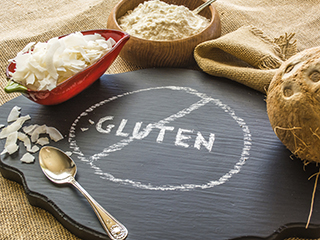To ‘G’ or not to ‘G’: Should you go gluten-free?

The gluten-free diet is the latest nutrition craze. Books, articles and TV shows tout the benefits of axing gluten, and it’s hard to walk down the grocery store aisle without encountering a raft of gluten-free products. A survey by Consumer Reports shows over 60% of Americans think that going gluten-free can improve their physical and mental health.
Advocates claim avoiding gluten leads to better digestion and gastrointestinal function, weight loss, higher energy, lower cholesterol, and a stronger immune system. There are even products to help you “detox” your body from gluten, suggesting that it is harmful.
So what is gluten, and are there health benefits to going gluten-free?
Gluten refers to a protein found in wheat, barley and rye. Cutting gluten out of your diet means cutting out gluten-containing bread, soup, pasta, cereal, and virtually any food or drink containing wheat, barley, rye or triticale (a newer grain with a similar quality as wheat).
There are people who definitely need to avoid gluten. Those with celiac disease ─ around 1% of Americans ─ may experience severe inflammation and damage to the lining of their small intestine. Even a small amount of gluten can cause bloating, cramping or skin rashes. Other people, who have gluten intolerance or sensitivity, do not suffer intestinal damage but may experience headaches, bloating, fatigue or diarrhea after eating foods with gluten.
For this relatively small group of people, a gluten-free diet functions as a detox diet by relieving their system of an irritant, and it can make a significant improvement in their quality of life.
For everyone else, research does not support the idea that cutting out gluten promotes good health. In fact, there are some good reasons not to go gluten-free:
Because wheat is ubiquitous in the American diet, completely eliminating gluten requires adopting a whole new diet. You would have to give up most breads, crackers, breakfast cereals, conventional pastas, pastry goods, beer and a wide range of processed foods made with small amounts of gluten.
Whole grains, which contain gluten, are rich in an array of vitamins and minerals, such as B vitamins and iron, as well as fiber. Studies show that whole-grain foods may help lower the risk of heart disease, type-2 diabetes, and some forms of cancer. The government’s Dietary Guidelines for Americans recommends that at least half of all carbohydrates in your diet come from whole-grain products.
A report from the American Dietetic Association warned that gluten-free products tend to be low in a wide range of important nutrients, including B vitamins, calcium, iron, zinc, magnesium, and fiber, so eliminating them may contribute to a nutritional deficiency.
Gluten-free does not automatically equal weight loss. Some gluten-free products make up for gluten by adding sugar and fat. In fact, a review of studies published in the Journal of Medicinal Food revealed that a gluten-free diet seems to increase the risk of overweight or obesity.
Most gluten-free alternatives, such as pasta and bread, are significantly more expensive than their conventional counterparts. A 2007 survey found that gluten-free pastas and breads were twice the price of conventional products, for instance.
If there are no proven benefits to a gluten-free diet, why do some people swear by it? It’s possible that, in addition to cutting out gluten, these people also make other, healthy changes, such as eating more fruits, vegetables, and lean meats, and fewer desserts and junk foods. These changes would naturally lead to feeling better and losing weight.
So, if you suspect you may have celiac disease or are gluten intolerant, see you doctor for testing and a diagnosis. If not, enjoy your gluten.
 Dr. Tracy Jansen is an MPCP partner and sees patients in the Pasadena office. She received her medical degree from Virginia Commonwealth University School of Medicine and completed her residency program in Family Practice at the Medical College of Georgia. She is certified by the American Board of Family Medicine.
Dr. Tracy Jansen is an MPCP partner and sees patients in the Pasadena office. She received her medical degree from Virginia Commonwealth University School of Medicine and completed her residency program in Family Practice at the Medical College of Georgia. She is certified by the American Board of Family Medicine.
Recommended Posts
Fad Diets and Holiday Weight Loss
By Janice Rutkowski, M.D.
Water for Weight Loss
By Manuel Skow, P.A.
Limiting Sugars in Your Diet
By Pio Poblete, M.D.





